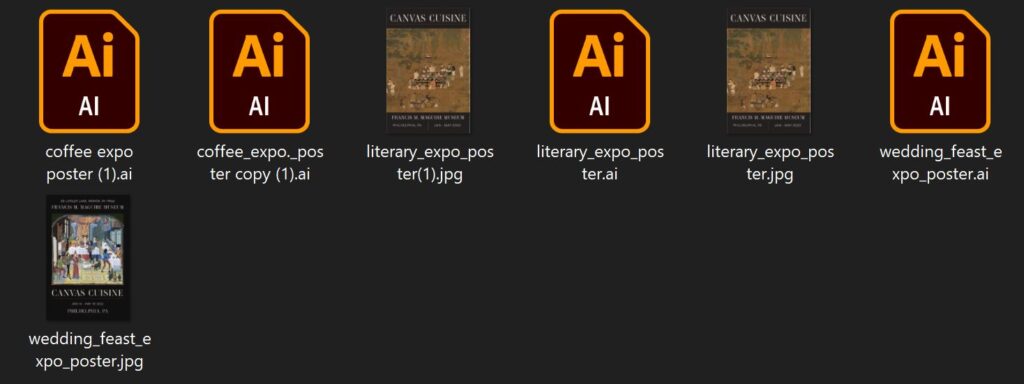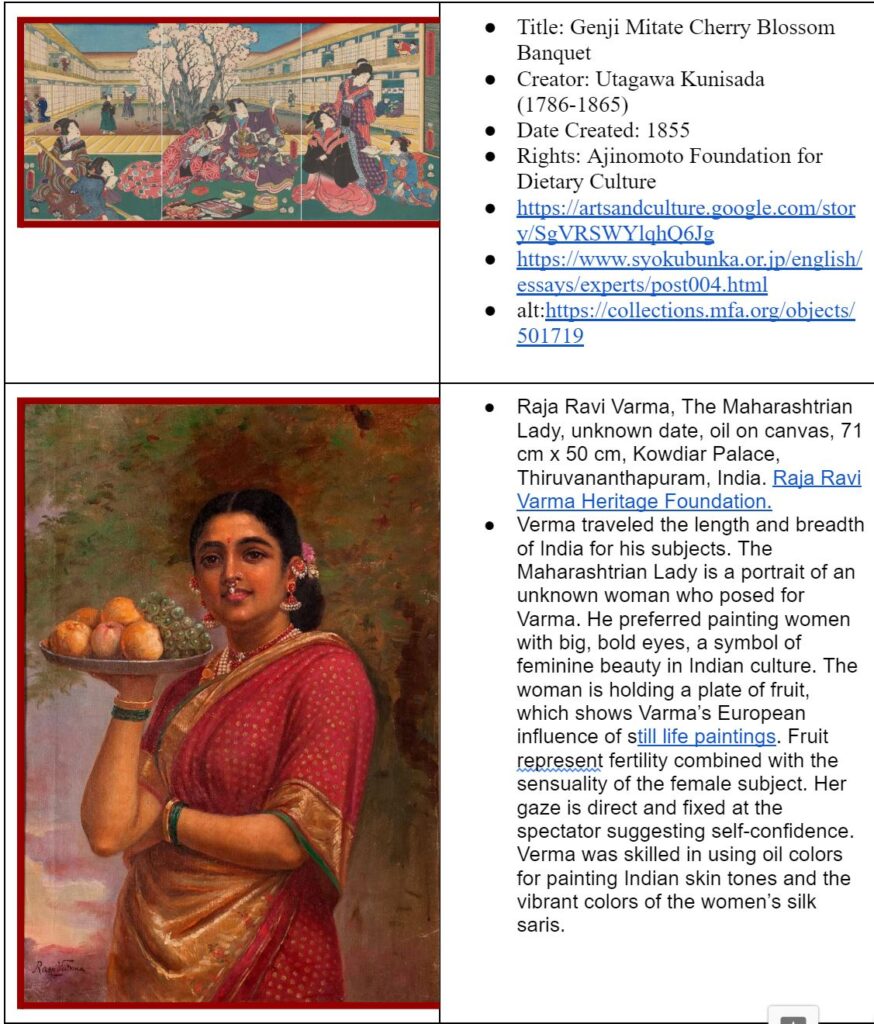PROJECT OVERVIEW:
Summary:
When thinking of culture, food and art are synonymous in it, both being a hallmark of a culture’s history and identity. My capstone brings the two together, highlighting the union of the two throughout history through 10 paintings throughout the world that highlight the flavors, persons, and motifs that made up food’s representation within art. Accompanying this gallery of diverse paintings, a campaign of varied posters, tickets, print, and media advertisements promote this exhibition, encouraging viewers to explore and enjoy what the virtual gallery has to offer. The exhibition and its contents demonstrate the diversity of food culture and substance within different societies throughout the world throughout its history and engage viewers with a new scope of historical, artistic, and cultural appreciation.
PRIOR EXPERIENCE RELATED TO THE PROJECT:
Art History:

Modern Muses- a past example of my experience making exhibition panels
Before this project, I had experience in all aspects of the capstone I’ve chosen. From the perspective of the art exhibit, I’ve previously made a modern art history exhibit called “Modern Muses: The Role and Depiction of Sexuality and Femininity in Twentieth-Century Art”.
Marketing:
My marketing side of this campaign is based on previous experiences I’ve done with mini-campaigns within college and DECA, with both basing campaigns on mediums, materials, and aesthetics that admittedly are geared towards different audiences. Nonetheless, preparation for this specific project has been well prepared, with more modern and sleeker content, aesthetics, and marketing being geared towards my gallery work.
TRIALS AND TRIBULATIONS:
In terms of content, this project has been rightfully suited for my skill set. However, I’ve been challenged by the time constraints I place upon myself in the early stages of the project that I now must rise to meet. While the ‘meat’ of the project has been met, for the most part, I’ve struggled to ensure the details of the project such as contacting and cementing the booklet’s printing in time for the presentation and completing the numerous (if not obscene) amount of ads I’ve promised to present. Regarding the art exhibit, I thrived in research and writing for it, but with marketing materials, I found that I didn’t allow enough time and consideration to other courses to have appropriate expectations.
PREP WORK AND BACKGROUND RESEARCH:
Making the Gallery:
As an academic-heavy capstone, my exhibition was largely reliant on research and quality work to make it appropriate for a “museum” gallery. My process mainly relied upon the resources given to me both by Saint Joseph’s library and what was available through other academic sources ranging from various museums, academic sources, primary records (records dating from the specific time of the work), and modern resources offering insight into the food culture and cuisine of specific periods and geographical areas.
- Annotated Bibliography
- The found sources and additional bibliography that was continuously built upon
- The list of potential paintings that I researched and chose from for my panels.
Marking the Marketing:
With the marketing, both intellectual and creative freedom was much more liberal, with my only guidelines being the demographic and socioeconomic statuses of audiences and the aesthetics that are associated with it. With this prep research, minimalistic but classic marketing aesthetics were best received, thus making it the primary styling of the entire campaign.

An example of some of the marketing research.
TECHNOLOGIES AND SOFTWARE:
Art Steps:
To make the gallery both accessible, easy to use, and practical for a capstone, Art Steps, a virtual gallery platform, was chosen to house the exhibition. Using the virtual downloads of paintings, the platform displays the paintings with their respective info panels and background when clicked upon.

An example of Art Steps layout.
Adobe Creative Suite:
For marketing, a myriad of Adobe programs is involved, including Illustrator, Photoshop, and InDesign. Photoshop and Illustrator have been the main applications used for the making of the marketing materials, with Illustrator being the best application for text design, formatting, and editing details, and Photoshop the best for photo editing and manipulation.

My numerous drafts in progress done in illustrator and photoshop.
PROJECT CONSIDERATIONS:
Diversity and Ethics:
When making a capstone that is intended for the public, inclusivity and diversity must be incorporated into every aspect of the project.
As a project that focuses on food and the culture around it throughout world history, Canvas Cuisine is an educational and engaging experience that exposes viewers to a diverse range of food history and culture through art, representing artists and communities from every continent. The gallery highlights artists and paintings that are overlooked in often-Eurocentric art history and institutions, offering audiences of any type find art and content that resonates with them and helps them gain a deeper appreciation for different cultures.
Inclusive Design:
With ethical creation, inclusivity must also be the main factor in anything regarding Canvas Cuisine as a multimedia project. With all the painting within the gallery, alt-captioning that describes and clarifies the content is available to anyone, and the gallery itself has an ease of use that doesn’t require heavy motor skill or dexterity. The marketing materials also all are legible and keep in mind color-blindness considerations.

Accessibility testing for color blindness
CREATION PROCESS:
- Art finding and research
- Meet with an advisor to plan out art themes and contents
- Further research for potential paintings
- Select the final 10 paintings for panels
- Write info panels and introduction
- Research potential marketing material inspiration from other museum exhibitions
- Start drawing out rough drafts for different ads and marketing materials
- Select and finalize marketing themes (typography, color scheme)
- Make marketing materials with Adobe Illustrator and Photoshop.
- Format exhibition booklet to send to SJU Printing
- Upload info panels and paintings to Art Steps
- My ad brainstorming process, including sketching and personal notes.
- billboard sketching
- exhibition poster sketching
FINAL DELIVERABLES:
- Booklet:
- Features each painting and full description/information about paintings
- Printed by SJU Printing
- Virtual Art Gallery:
- Art Steps platform
- Marketing Campaign:
- Adobe Illustrator and Photoshop
- Includes tickets, 3 exhibition posters, 8-10 ads








Leave a Reply